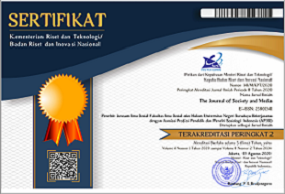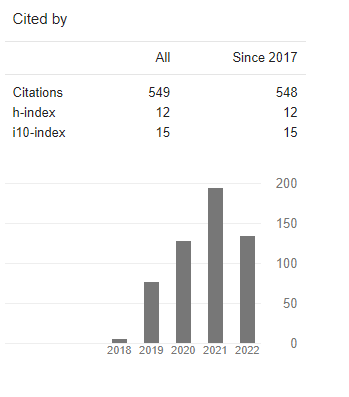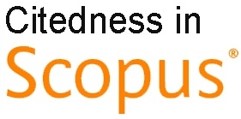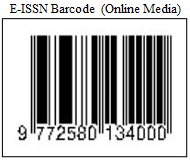CRITICISM IN COVID-19 RESPONSES AT VOLUNTEER ACCOUNT @PANDEMICTALKS (NORMAN FAIRCLOUGH'S CRITICAL DISCOURSE ANALYSIS MODEL)
DOI:
https://doi.org/10.26740/jsm.v5n2.p409-437Keywords:
covid-19, pandemic, critical discourse analysis, norman fairclough, pandemictalksAbstract
The Covid-19 pandemic in Indonesia since March 2020 has tested the Indonesian government's capabilities in various aspects, including public health communication. The existence of communication media both from the Government and the mass media is considered insufficient in providing information related to Covid-19. The advancement of the internet and new media has made social media, especially Instagram, play a vital role in disseminating information related to Covid-19. The information gap that occurs encourages netizens to collaborate to fill it. One of the information volunteers regarding Covid-19 is the Instagram account @pandemictalks, with educational content and criticism of the handling of Covid -19 in Indonesia. This study captures how the discourse on the handling of Covid-19 was put forward by the volunteer account @pandemictalks. This study uses Norman Fairclough's Critical Discourse Analysis Model, this model dissects discourse not only from the linguistic aspect but also into the social aspect and the context involved in it. This study provides an overview of the various forms of criticism that @pandemictalks conveyed, their production and distribution, social changes that occurred, and related policy changes in them.
References
Agus Indiyanto, A. K. (2021). Konstruksi Masyarakat Tangguh Bencana. Mizan.
Bungin, B. (2006). Sosiologi Komunikasi (9th ed.). Kencana.
Clay Shirky. (2008). Here Comes Everybody. Penguins Books.
Djalante, R., Lassa, J., Setiamarga, D., Sudjatma, A., Indrawan, M., Haryanto, B., Mahfud, C., Sinapoy, M. S., Djalante, S., Rafliana, I., Gunawan, L. A., Surtiari, G. A. K., & Warsilah, H. (2020). Review and analysis of current responses to COVID-19 in Indonesia: Period of January to March 2020. Progress in Disaster Science, 6, 100091. https://doi.org/10.1016/j.pdisas.2020.100091
Fairclough, N. (1993). Discourse and Social Change. In Contemporary Sociology (Vol. 22, Issue 5). https://doi.org/10.2307/2074659
Fairclough, N. (1997). Critical Discourse Analysis: The Critical Analysis of Language. In Language (Vol. 73, Issue 1). Longman. https://doi.org/10.2307/416612
Fairclough, N. (2003). Analysing Discourse. Routledge.
Fisher, D. A., & Carson, G. (2020). Back to basics: the outbreak response pillars. The Lancet, 396(10251), 598. https://doi.org/10.1016/S0140-6736(20)31760-8
Foucault, M. (1980). Power/Knowledge: Selected Interview & Other Writing 1972-1977. Pantheon Books.
Google. (2020). Year in Seach 2020. In Think with Google. https://doi.org/10.1177/0022427813520446
Haddow, Kim, B. (2009). Global Warming, Natural Hazards, and Emergency Management. CRC Press. http://library1.nida.ac.th/termpaper6/sd/2554/19755.pdf
Ida, R. (2014). Metode Penelitian Studi Media dan Kajian Budaya. Prenada Media.
Islm, T., Meng, H., Pitafi, A. H., Ullah Zafar, A., Sheikh, Z., Shujaat Mubarik, M., & Liang, X. (2021). Why DO citizens engage in government social media accounts during COVID-19 pandemic? A comparative study. Telematics and Informatics, 62(July 2020), 101619. https://doi.org/10.1016/j.tele.2021.101619
Jurkowitz, Mark; Mitchell, A. (2020). American who primarily get news through social media are least likely to follow COVID-19 coverage, most likely to report seeing made-up news. Pew Research Center.
Mandiberg, M. (2012). The Social Media Reader. New York University Press. https://doi.org/10.1057/9781137270061
Mukti, O. F. W., & Putri, N. K. (2021). Social Media Analytics: Instagram Utilization for Delivering Health Education Messages to Young Adult in Indonesia. Jurnal PROMKES, 9(1), 36. https://doi.org/10.20473/jpk.v9.i1.2021.36-43
Nasrullah, R. (2015). Media Sosial. Simbiosa Rekatama Media.
Neely, S., Eldredge, C., & Sanders, R. (2021). Health Information Seeking Behaviors on Social Media During the COVID-19 Pandemic Among American Social Networking Site Users: Survey Study. J Med Internet Res, 23(6), e29802. https://doi.org/10.2196/29802
Neuman, L. (2004). Basics Social Research. Pearson Education. http://library1.nida.ac.th/termpaper6/sd/2554/19755.pdf
Rudianto et. al. (2020). Krisis Komunikasi dalam Pandemi Covid-19 (F. Junaedi, Ed.). Buku Litera.
Ruth Wodak, M. M. (2001). Methods of Critical Discourse Analysis. Sage Publications.
Saud, M., Mashud, M., & Ida, R. (2020). Usage of social media during the pandemic: Seeking support and awareness about COVID-19 through social media platforms. Journal of Public Affairs, 20(4). https://doi.org/10.1002/pa.2417
The Lancet Infectious Diseases. (2020). The COVID-19 infodemic. The Lancet Infectious Diseases, 20(8), 875. https://doi.org/10.1016/S1473-3099(20)30565-X
Wahyuni, H. I., & Ambardi, K. (2020). Problem Infodemic dalam merespon Pandemi Covid-19. Policy Brief, 2201, 14. https://fisipol.ugm.ac.id/wp-content/uploads/sites/1056/2020/04/Policy-Brief-Problem-Infodemic-dalam-Merespon-Pandemi-COVID-19.pdf
We Are Social. (2021). Digital Report 2021 : Indonesia. In Global Digital Insights.
Downloads
Published
How to Cite
Issue
Section
License
Copyright (c) 2021 The Journal of Society and Media

This work is licensed under a Creative Commons Attribution 4.0 International License.
 Abstract views: 811
,
Abstract views: 811
, PDF Downloads: 610
PDF Downloads: 610












